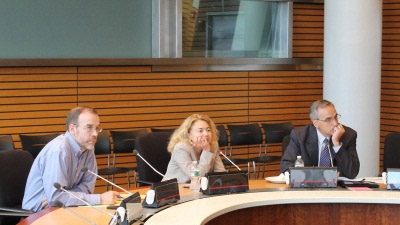Trends in inequality around the world have become a focus of media attention and policy debate over the last few years. From the conversation about increasing inequality that Thomas Piketty’s research has prompted to protests against wealth concentration in rich countries, the issue is at the forefront of public concern and the development policy agenda.
This June’s Policy Research Talk, a monthly series hosted by the World Bank’s research department, was presented by Senior Research Adviser Aart Kraay. His talk drew on his recent working paper, “Growth, Inequality and Social Welfare: Cross-Country Evidence” (authored jointly with David Dollar of the Brookings Institution and Tatjana Kleineberg of Yale University).
“There are concerns about rising inequality everywhere around the world, even in the most conservative corners,” said World Bank Research Director Asli Demirguc-Kunt. Referring to the World Bank’s twin goals of poverty reduction and shared prosperity, she added, “The World Bank has signaled that it is sensitive to inequality issues by committing to monitor the growth in the average incomes of those in the bottom 40 percent of the income distribution in every developing country. So what does shared prosperity mean? What sort of a social welfare function does this goal correspond to?”
While there is evidence of rising inequality, not all countries are experiencing this trend in the same way. According to a 2013 Pew Research Center survey, a median of 80 percent of respondents in developed countries perceive income inequality to have worsened, compared to medians of 70 percent in developing economies and 59 percent in emerging markets. Inequality has indeed increased in some countries, for example in the United States over the past 40 years and China over the past 20. However, inequality has remained stable in countries such as Japan, Switzerland, and Germany, and even fallen significantly in countries such as Brazil.
While debates about inequality touch on many areas, Kraay focused his discussion on one particular question: how much do trends in inequality matter for changes in social welfare?
Kraay relied on a variety of standard social welfare functions to assess the importance of changes in inequality, relative to changes in average incomes, for growth in social welfare. This approach serves two purposes: it provides useful perspective on whether changes in inequality are big or small, and it makes explicit what various measures of inequality imply for the weight placed on individuals at various points of the income distribution. Using China as an illustrative example, Kraay examined what the trade-offs in terms of growth and inequality look like when relying on the World Bank’s own goal of shared prosperity, defined as growth in average incomes in the bottom 40%. Between 1990 and 2007, growth in average incomes in China was 6.7%, while growth in the income share of the bottom 40% was -1.7%, so growth in social welfare still amounted to a notable 5.0%.

